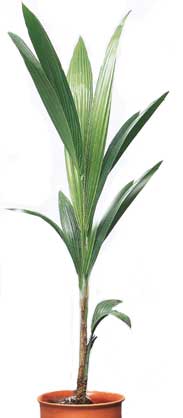Coconut / cocos
Refers to the family of palm trees. Fatherland is a tropical belt.
General description: Coconut is poorly adapted for living in room conditions. A couple of relatively compact species is usually grown:
Cocos nucifera can grow up to 3 m. It has very large feathery leaves.
Cocos weddeliana (Voddel Coconut or Vecdel microclum, or Weddel's siagrus). His leaves are drooping, narrow leaves, silver on the underside. It is considered the most beautiful room palm tree, but, most likely, in a couple of years and it will have to be transferred to a greenhouse.
Recommendations for caring for the plant Coconut:
Illumination : photophilous, shading is needed only in the summer noon.
Irrigation regime : Abundant during growth, moderate in winter.
Humidity : Requires regular spraying and wiping of leaves with a damp soft cloth.
For summer it is better to place on a fresh atmosphere (in a park or on a balcony), in a room protected from wind and from direct sunlight.
Temperature mode : Optimum 20-23 ° C.
Soil : Recommended soil mishmash: 2 elements of clay-sod land, 2 parts humus-leaf, 1 part peat, 1 part of the manure and 1 part of sand, add charcoal.
During the growth period, it needs fertilizing once every 2 weeks with complex mineral fertilizers.
Breeding : With soil warming and high humidity of the atmosphere, nuts are sprouted.
Transplantation : Transplanted in the spring, at what time the pot is made tight (the roots begin to germinate through the drainage holes).
Transplant is bad.
Pests : Most often it is affected by mealybugs (covered with white cotton woolly fluff) and scabbards (brown plaques appear on the leaves and stems, leaving sticky excretions), a spider mite (in a dry atmosphere, leaves and stems are braided with cobwebs).
The plant is allowed to help finish with a soap solution, warm washing and spraying with an actinic (1-2 ml per liter of water).

Coconut - Cocos


Comments
Commenting on, remember that the content and tone of your message can hurt the feelings of real people, show respect and tolerance to your interlocutors even if you do not share their opinion, your behavior in the conditions of freedom of expression and anonymity provided by the Internet, changes Not only virtual, but also the real world. All comments are hidden from the index, spam is controlled.